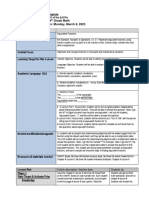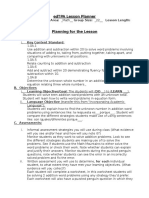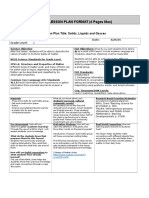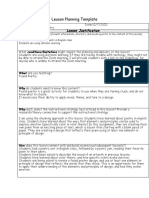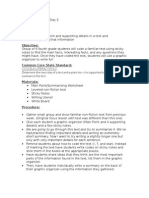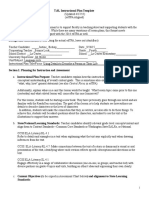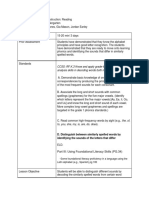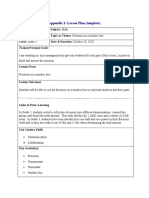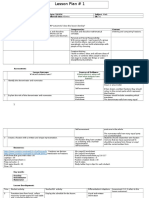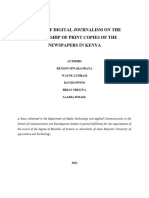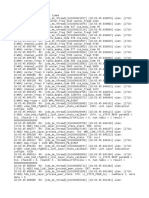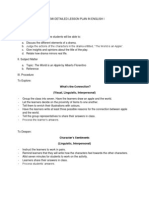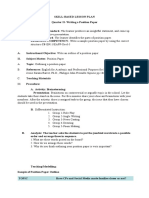Instructional Strategy Lesson One
Instructional Strategy Lesson One
Uploaded by
api-242127878Copyright:
Available Formats
Instructional Strategy Lesson One
Instructional Strategy Lesson One
Uploaded by
api-242127878Original Title
Copyright
Available Formats
Share this document
Did you find this document useful?
Is this content inappropriate?
Copyright:
Available Formats
Instructional Strategy Lesson One
Instructional Strategy Lesson One
Uploaded by
api-242127878Copyright:
Available Formats
Equivalent Fractions Name: Kacey Mohon Time Allotted: 45 minutes rd Grade Level: 3 Subject: Math Materials Required: Fraction
n Circles for each student and a teacher set for the board Equivalent Fractions Worksheet (enough for each student) Michigan Content Expectations Recognize and generate simple equivalent fractions, e.g., 1/2 = 2/4, 4/6 = 2/3). Explain why the fractions are equivalent, e.g., by using a visual fraction model. *Students learnt how to recognize simple equivalent fractions in a previous lesson Objectives: Teacher Friendly Objective: The student will use fraction circles to explain why two fractions are equivalent and mastery will be shown by a student receiving 2 out of 3 on the Equivalent Fractions Worksheet Rubric. Student Friendly Objective: The student will use fraction circles to explain why two fractions are equivalent. Assessment: Informal Formative: During modeling I will ask students if they remember any equivalent fractions that we talked about in prior lessons. This will help me to see how many students remembered the information previously taught. I will be able to reteach or guide the students to remembering this information if need be. Informal Formative: After modeling how to use fraction circles, I will have the students work in pairs to practice using fraction circles during guided practice. During this time I will be walking around the room to check for understanding. If students are having a hard time I will show more examples to the whole class while having the students work with me to figure out the correct answers. Formal Summative: Once the students have shown understanding on how to use fraction circles during guided practice I will pass out the Equivalent Fractions Worksheet. The students are then to work independently on the worksheet to show me what they now. First the students will use their fraction circles to make a visual representation and then the students are to fill in the circles on the worksheet. In order to show mastery students need to correctly answer 2 out of the 3 questions. Requirements 4 3 2 1 I Student was Not The student The student The student The student able to explain applicable correctly correctly correctly did not if two for this answered answered 2 answered 1 complete the fractions are lesson. 3 out of 3 out of 3 out of 3 worksheet or equivalent by questions. questions. questions. did not using fraction answer any circles. correct.
Instructional Procedure: 1. Anticipatory Set: Tell the students that for todays math lesson we are going to continue learning about equivalent fractions, but today we are going to learn how to use fraction circles to visually represent fractions. Have a student read the posted student friendly objective that is written on the board. Remind the students that you have full faith in their ability to learn fractions and that you know they will do awesome. Make sure to remind students about our class procedure on how to properly use manipulatives of any sort. Talk to the students about how they colored the fraction circles before based on the color that was labeled below each circle. Tell them that they will be using those circles for todays lesson and that each fraction has its own color to help them to better understand how fractions are divided up using circles. 2. Instructional Input/Direct Instruction: The teacher will ask students a question to see if students can explain what equivalent fractions are and if they can give examples from the previous lesson, explain what fraction circles are, model how to use fraction circles, and walk around the room to check for student understanding. 3. Modeling: Ask if anyone can remember what an equivalent fraction is. Then have students give examples of equivalent fractions. Then explain that fraction circles are visual representations of a fraction. The circles are dived into equal parts based off of the fraction that it is representing. Have students take out the two pieces to the yellow fraction circle and ask students if they can guess what fraction this circle represents (2/2). While the students are doing this post the teacher version of the circles on the board so students can see what I mean. Then have students take out their four blue pieces and make a circle out of them. Ask students if they can guess what fraction this circle represents (4/4). Post the teacher version of this on the board as well. Then tell the students that you are going to compare the following two fractions 1/2 and 2/4. To model 1/2 take one yellow piece off the board and to model 2/4 take two blue pieces off of the board. Make sure to write 1/2 below the yellow piece and 2/4 below the blue pieces. Explain to the students why each of these models represents the fraction. Then talk to the students about how each fraction is equal because the reminder of each circle is the same size. Do this again for the following two equivalent fraction pairs: 2/3 and 4/6, 1/3 and 2/6, but use the proper fraction circles. Have students explain the reasoning as to way the fraction circles show that the fractions are equal. Then do 1/3 and 1/2 on the board. Ask students if these to fractions are equivalent. Why or why not? 4. Guided Practice:
Leave the examples on the board and tell students that they are to work with their assigned partner to do the following fraction pairs to determine if they are equivalent or not. Tell them to be ready to explain why or why not by using their fraction circles. 1/2 and 3/6 1/1 and 3/3 2/4 and 2/3 2/3 and 4/6 Walk around the room and check for student understanding. Have four student pairs take turns going up to the board to represent each fraction using the teacher fraction circles and explain why or why not the two fractions are equivalent.
5. Independent Practice: Pass out the Equivalent Fractions Worksheet. Explain to the students that they are to work independently on the work sheet to show me what they know. Go over the instructions with the student that are on the worksheet. Create the fractions on the work sheet using your own fraction circles. Draw the fractions in the circles just like it looks on the fraction circles that you put together on your table using your manipulatives. Do not worry about getting it perfectly correct. Compare the two fraction circles to determine if the fractions are equivalent and then write yes if they are and no if they are not. Then explain why. Tell them that in order to show me that they know how to use fraction circles well they need to get 2 out of the 3 problems correctly. 6. Differentiated Consideration If students finish early allow for them to try to see how many equivalent fractions they can make out of their fraction circles at their desk. If students do not finish allow for them to complete their work sheet at a center during centers. Visual-Spatial Intelligence: These students are reached by being able to draw by copying their fraction circles onto paper. Bodily-kinesthetic- These students are reached by being able to manipulate their fraction circles in order to represent different fractions. Interpersonal Intelligence- these students are reached by being able to work in pairs during guided practice. Intrapersonal Intelligence- these students are reached by being able to complete the worksheet on their own. Logical Mathematical Intelligence- These students are reached by being able to see how fractions are or are not equivalent by using the fraction circles. . 7. Closure: Have a student reread the objective on the board. Have another student determine if the objective was meant and tell how it was meant.
Tell the students that you are proud of how hard they worked and that you are here if they ever have any questions.
8. References: Cramer , K., Behr, M., Post, T., & Lesh, R. (1997).Rational number project: Fraction lessons for the middle grades - level 1. Dubuque, IA: Kendall/Hunt Publishing Company.
Equivalent Fractions Worksheet
Use your fraction circles to represent the following fraction pairs. Then draw the visual in the circles provided. Make sure to color in the parts of the circle to represent the fraction. Then circle if the fractions are equivalent or not. After explain why or why not. 1) 2/3 4/6 Are they equivalent? Yes or No Why or why not?
2)
1/3
1/2
Are they equivalent? Yes or No Why or why not?
3)
1/2
2/4
Are they equivalent? Yes or No Why or why not?
You might also like
- Fractions Backwards DesignDocument12 pagesFractions Backwards Designapi-261915236100% (4)
- Pirate Addition First Grade Lesson PlanDocument3 pagesPirate Addition First Grade Lesson Planapi-298522270No ratings yet
- Lbs 302 Classroom Management PlanDocument10 pagesLbs 302 Classroom Management Planapi-437553094No ratings yet
- Experiential AssignmentsDocument2 pagesExperiential AssignmentstarandeepsinghNo ratings yet
- Edtpa Lesson PlansDocument10 pagesEdtpa Lesson Plansapi-666398954No ratings yet
- Lesson 1 EdtpaDocument5 pagesLesson 1 Edtpaapi-323461891No ratings yet
- Ted 410 Math LessonDocument9 pagesTed 410 Math Lessonapi-486956371No ratings yet
- Siop Lesson Plan 1Document6 pagesSiop Lesson Plan 1api-522660932No ratings yet
- Learning Segment-And 5 Day Lesson Plan TemplateDocument7 pagesLearning Segment-And 5 Day Lesson Plan Templateapi-438417920No ratings yet
- Edtpa Lessons 5-8Document15 pagesEdtpa Lessons 5-8api-282136083No ratings yet
- Walker Task4 CLDocument4 pagesWalker Task4 CLapi-437574083No ratings yet
- Task 4 Final DraftDocument15 pagesTask 4 Final Draftapi-297270110No ratings yet
- Edtpa Math Lesson 1Document3 pagesEdtpa Math Lesson 1api-3266969840% (1)
- Siop Lesson PlanDocument2 pagesSiop Lesson Planapi-445759289No ratings yet
- Subject Assignment: Teaching English Through Translation: General InformationDocument3 pagesSubject Assignment: Teaching English Through Translation: General InformationJonathan VidesNo ratings yet
- Visual Analysis GuidelinesDocument5 pagesVisual Analysis Guidelinesjennifer0% (1)
- Unit One/ Writing: Correcting MistakesDocument7 pagesUnit One/ Writing: Correcting MistakesAbdulaziz hazem100% (1)
- Survey QuestionnaireDocument3 pagesSurvey QuestionnaireHussain Aftab Changi100% (3)
- Edtpa Lesson Plan Format (4 Pages Max)Document5 pagesEdtpa Lesson Plan Format (4 Pages Max)api-28847298No ratings yet
- Part A Literacy Context For Learning InformationDocument3 pagesPart A Literacy Context For Learning Informationapi-256550524No ratings yet
- Educ 1301 - Field Experience 2Document10 pagesEduc 1301 - Field Experience 2api-610903961100% (1)
- Adding and Subtracting Whole NumbersDocument7 pagesAdding and Subtracting Whole Numbersapi-234983083100% (1)
- SIOP Unit FINAL VersionDocument42 pagesSIOP Unit FINAL VersionAndrewNo ratings yet
- Lesson Plan KindergardenDocument4 pagesLesson Plan Kindergardenapi-272644220No ratings yet
- Math Lesson Plans: 7.4 ParenthesesDocument3 pagesMath Lesson Plans: 7.4 ParenthesesJuanita Castro BarreraNo ratings yet
- Lesson PlanDocument7 pagesLesson Planapi-317738807No ratings yet
- Found Poetry Lesson Planning Template EdtpaDocument5 pagesFound Poetry Lesson Planning Template Edtpaapi-534200203No ratings yet
- edTPA Task 1 Day 2Document1 pageedTPA Task 1 Day 2Chelsea KeeneyNo ratings yet
- Manhattan College Education Department Lesson Plan TemplateDocument10 pagesManhattan College Education Department Lesson Plan Templateapi-534924709No ratings yet
- Fraction On Number LineDocument6 pagesFraction On Number LineMaitha ANo ratings yet
- Continent Lesson PlanDocument2 pagesContinent Lesson Planapi-438148523No ratings yet
- ELD Levels/can Do Descriptors, Etc.) : This Lesson Is Intended For Use in A 9th Grade ELADocument18 pagesELD Levels/can Do Descriptors, Etc.) : This Lesson Is Intended For Use in A 9th Grade ELADanahNo ratings yet
- Assessment Commentary 4Document13 pagesAssessment Commentary 4Shahadiar HabibNo ratings yet
- Studentteaching Ela Edtpa LessonplanDocument8 pagesStudentteaching Ela Edtpa Lessonplanapi-301667326No ratings yet
- 4th Grade Math LessonDocument3 pages4th Grade Math Lessonapi-239773259No ratings yet
- Edtpa Lesson PlanDocument4 pagesEdtpa Lesson Planapi-405532979No ratings yet
- Siop Lesson Plan ConstituionDocument4 pagesSiop Lesson Plan Constituionapi-522436376No ratings yet
- LP 1Document4 pagesLP 1api-351421679No ratings yet
- Reading Notes CH 10Document3 pagesReading Notes CH 10api-550356295No ratings yet
- CCSS - ELA-LITERACY - RL.3.2 Recount Stories, Including Fables, Folktales, and MythsDocument5 pagesCCSS - ELA-LITERACY - RL.3.2 Recount Stories, Including Fables, Folktales, and Mythsapi-353115054No ratings yet
- Lesson Plan Ted 508Document4 pagesLesson Plan Ted 508api-486161267100% (1)
- Sample Co-Teaching Lesson Plan (Direct Instruction) : Time: 3 MinutesDocument5 pagesSample Co-Teaching Lesson Plan (Direct Instruction) : Time: 3 Minutesapi-307753858No ratings yet
- Weber EdTPA ELE LIT Assessment CommentaryDocument5 pagesWeber EdTPA ELE LIT Assessment Commentary100129635No ratings yet
- Culture and Inclusion Reflective Essay #3 - ReidyDocument7 pagesCulture and Inclusion Reflective Essay #3 - ReidyGina100% (1)
- Fractions On A Number LineDocument4 pagesFractions On A Number LineSabha HamadNo ratings yet
- Lesson Plan Form: CCSS - Math.Content.K.G.A.2Document4 pagesLesson Plan Form: CCSS - Math.Content.K.G.A.2api-317511394No ratings yet
- Mini Lesson Plan 7Document3 pagesMini Lesson Plan 7api-260889954100% (1)
- Math Lesson 1Document4 pagesMath Lesson 1api-249091828No ratings yet
- Differentiated Lesson Plan Written ExpressionDocument5 pagesDifferentiated Lesson Plan Written Expressionapi-597970375No ratings yet
- 5th Grade Math Lesson PlanDocument9 pages5th Grade Math Lesson Planapi-456575196No ratings yet
- Lesson 2 Unit PlanDocument5 pagesLesson 2 Unit Planapi-300384449No ratings yet
- Blease Task1 LPDocument20 pagesBlease Task1 LPapi-265863941No ratings yet
- Lesson 1 FractionsDocument6 pagesLesson 1 Fractionsapi-296318672No ratings yet
- Artifact #5: Guided Reading Lesson Plan - EDL 550 Developmental LiteracyDocument14 pagesArtifact #5: Guided Reading Lesson Plan - EDL 550 Developmental Literacyapi-288924191No ratings yet
- Literacy and Social Studies Lesson PlanDocument7 pagesLiteracy and Social Studies Lesson Planapi-411494189100% (1)
- Task 1: Planning Commentary: 1. Central FocusDocument4 pagesTask 1: Planning Commentary: 1. Central FocusNicole WalstromNo ratings yet
- 1 Lesson Plan SAMPLE EdTPA Task 1Document2 pages1 Lesson Plan SAMPLE EdTPA Task 1Callie ChiltonNo ratings yet
- Latitude and Longitude Unit PlanDocument6 pagesLatitude and Longitude Unit Planapi-508622766No ratings yet
- Transcontinental Railroad Lesson PlanDocument9 pagesTranscontinental Railroad Lesson Planapi-287109691No ratings yet
- edTPA-Task 1 Day 1Document2 pagesedTPA-Task 1 Day 1Chelsea Keeney100% (1)
- Nouns, Verbs, Adjectives, Adverbs, Oh My!Document4 pagesNouns, Verbs, Adjectives, Adverbs, Oh My!Nia Chen100% (1)
- Lesson Plan WeeblyDocument5 pagesLesson Plan Weeblyapi-253455694No ratings yet
- Sample Lesson Plan: Grade Math - Equivalent FractionsDocument5 pagesSample Lesson Plan: Grade Math - Equivalent Fractionsapi-290792376No ratings yet
- Hearing Impaired Lesson PlanDocument6 pagesHearing Impaired Lesson Planapi-316000846No ratings yet
- Math Lesson PortfolioDocument7 pagesMath Lesson Portfolioapi-310961869No ratings yet
- KWL Chart: Think, Pair, ShareDocument13 pagesKWL Chart: Think, Pair, Shareapi-242127878No ratings yet
- 350 Lesson Plan MovementDocument9 pages350 Lesson Plan Movementapi-242127878No ratings yet
- Pink and SayDocument4 pagesPink and Sayapi-242127878No ratings yet
- The Midwest Region (Strategies)Document12 pagesThe Midwest Region (Strategies)api-242127878No ratings yet
- Lesson Plan: TH THDocument3 pagesLesson Plan: TH THapi-242127878No ratings yet
- Wild About The AlphabetDocument10 pagesWild About The Alphabetapi-242127878No ratings yet
- 350 Sbu - Water As A Resoure Edu429Document11 pages350 Sbu - Water As A Resoure Edu429api-242127878No ratings yet
- ElkoninDocument3 pagesElkoninapi-242127878No ratings yet
- Landform QuestionsDocument2 pagesLandform Questionsapi-242127878No ratings yet
- Bingocard 1Document1 pageBingocard 1api-242127878No ratings yet
- Landform Fill in The Blank Answer KeyDocument1 pageLandform Fill in The Blank Answer Keyapi-242127878No ratings yet
- Landform Bingo CuesDocument1 pageLandform Bingo Cuesapi-242127878No ratings yet
- Earths Landforms Lesson2Document6 pagesEarths Landforms Lesson2api-242127878No ratings yet
- LandformslessonDocument11 pagesLandformslessonapi-242127878No ratings yet
- 350 Unit Properties of Water LP The Good One - Edu 4292Document17 pages350 Unit Properties of Water LP The Good One - Edu 4292api-242127878No ratings yet
- Phonology Phriend or Phoe Ray ParkerDocument51 pagesPhonology Phriend or Phoe Ray ParkerPauline IntiaNo ratings yet
- Mobile Learning To Support Teaching EnglDocument8 pagesMobile Learning To Support Teaching EnglJihan Aura LestariNo ratings yet
- An Emperical Anlaysis of Digital Marketing in Pharma IndustryDocument5 pagesAn Emperical Anlaysis of Digital Marketing in Pharma IndustrySANKET PAGARNo ratings yet
- Vernacular Vs Standard LanguagesDocument8 pagesVernacular Vs Standard Languagesnoor stampNo ratings yet
- Make Something You Love: Hamin Lee, Jeremy Ostrow, Claire Shannon, Bryan ZakalikDocument16 pagesMake Something You Love: Hamin Lee, Jeremy Ostrow, Claire Shannon, Bryan ZakalikTushar BallabhNo ratings yet
- Listening and Speaking SkillsDocument2 pagesListening and Speaking Skillskhadijaasghar772No ratings yet
- Effect of Digital Media On Print CopiesDocument71 pagesEffect of Digital Media On Print CopiesWayne LumbasiNo ratings yet
- Term Two Basic Four Week 1 12Document258 pagesTerm Two Basic Four Week 1 12Tweneboah UriasNo ratings yet
- Alfredo Torres: Here'S My StoryDocument4 pagesAlfredo Torres: Here'S My StoryJaser ArafackNo ratings yet
- TEACHING STRATEGIES Debate FINALDocument5 pagesTEACHING STRATEGIES Debate FINALBrixValdrizNo ratings yet
- Spanish Grammar TipsDocument7 pagesSpanish Grammar TipsChittaranjan HatyNo ratings yet
- Pop Cycle Cunningham 11Document5 pagesPop Cycle Cunningham 11api-518590777No ratings yet
- Grade 10 - Lesson PlanDocument7 pagesGrade 10 - Lesson PlanMary Grace Batayo DucoNo ratings yet
- The French SchoolDocument2 pagesThe French SchoolTaimoor yasin100% (4)
- PALS Espanol 2016-17 v2Document2 pagesPALS Espanol 2016-17 v2Bild Andhra PradeshNo ratings yet
- General Information (1) Gender: (2) Age Group: (3) Level of EducationDocument2 pagesGeneral Information (1) Gender: (2) Age Group: (3) Level of EducationSaadMughalNo ratings yet
- English 5443: Intro To Tech Studies in CRL: Dr. Will Kurlinkus The University of OklahomaDocument24 pagesEnglish 5443: Intro To Tech Studies in CRL: Dr. Will Kurlinkus The University of OklahomaWill KurlinkusNo ratings yet
- Approaches Techniques and Method in TeachingDocument19 pagesApproaches Techniques and Method in Teachingmarjorie gervacio100% (2)
- Student Synthesis EssayDocument2 pagesStudent Synthesis EssayKookieNo ratings yet
- Host Driver Logs CurrentDocument6,009 pagesHost Driver Logs CurrentRizki SaputraNo ratings yet
- LINKS Lesson PlanDocument5 pagesLINKS Lesson PlanEstelle Nica Marie DunlaoNo ratings yet
- Cisco IP Communications Voice/Fax Network ModuleDocument12 pagesCisco IP Communications Voice/Fax Network ModuleAdhemar RodoNo ratings yet
- A Graphic Organizer For The Brain Based StrategiesDocument1 pageA Graphic Organizer For The Brain Based StrategiesMarc SalvadorNo ratings yet
- The World Is An AppleDocument2 pagesThe World Is An AppleDiNkoi Lacsina50% (6)
- English For Academic and Professional Purpose1 LPDocument3 pagesEnglish For Academic and Professional Purpose1 LPChar LayiNo ratings yet




